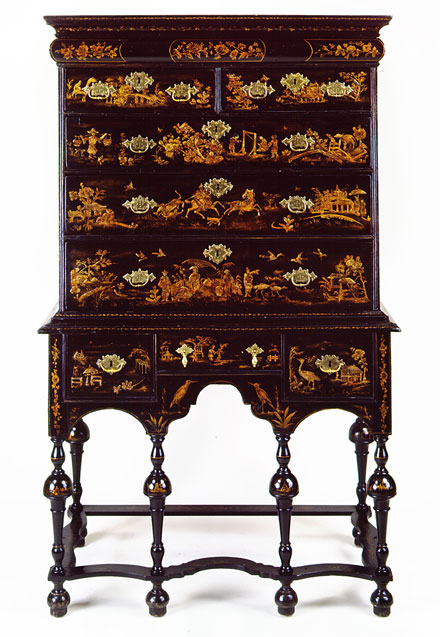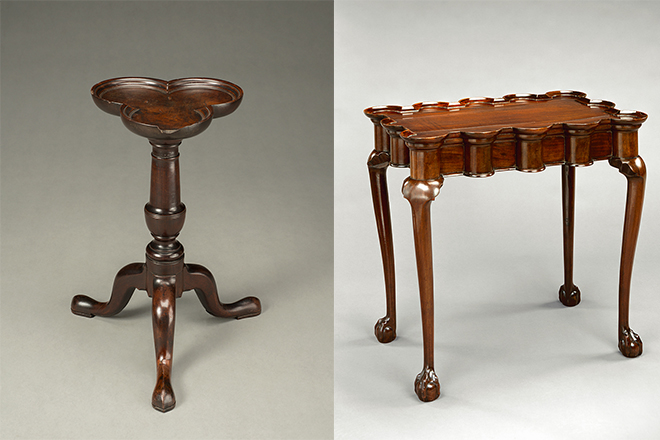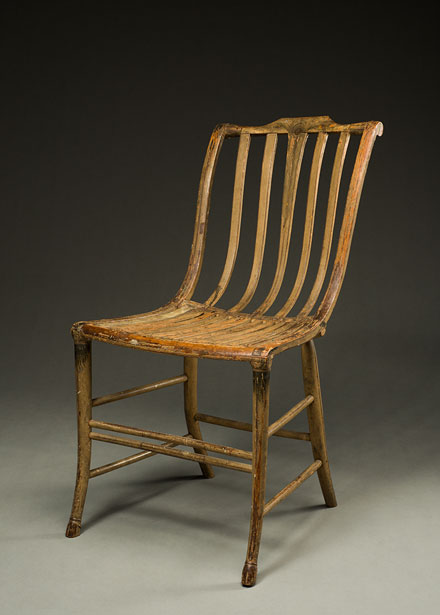Scholars, curators, and collectors of American furniture have eagerly awaited the Colonial Society of Massachusetts’ most recent publication Boston Furniture, 1700-1900 (2016), edited by Brock Jobe and Gerald W.R. Ward. The book, containing a collection of 19 essays, builds upon scholarship published 42 years earlier in Boston Furniture of the Eighteenth Century (1974), extends the research of Boston furniture into the nineteenth century, and presents new (and oftentimes groundbreaking) research on a variety of Boston furniture forms. The essays in the book range from fascinating object studies of single pieces and groups of related Boston furniture to essays focused on social history.
Readers of Boston Furniture, 1700-1900 will find that references are made to several important examples of eighteenth-century Boston furniture owned by Historic Deerfield (HD)—a testament to Deerfield’s strong collection of early Boston furniture. The first reference is to a japanned high chest in Tara Hingston Cederholm and Christine Palmer Thomson’s pioneering study on Boston japanned furniture.1Inspired by East Asian design, the black exterior surfaces of American japanned furniture imitated Chinese lacquered surfaces. Deerfield’s japanned high chest is only 1 of 53 examples of Boston japanned furniture known to exist—evidence of the rarity of the form (Fig. 1).2Boston japanned furniture is also unique as it appears to be the only American made japanned furniture that has survived to the present.3

Two additional references to Boston furniture forms owned by HD are made in Jobe and Allan Breed’s innovative study of Boston turret-top tea tables. As Jobe and Breed explain, these are a rare form among tea-tables. Only 5 examples are known to exist, one of which can be found in the collections of HD (Fig. 3).4Jobe and Breed go on to suggest several possible inspirations for the unique form: 1) English tilt-top tea tables with raised scalloped edges 2) English card tables and 3) an English japanned tea table.5The authors also cite a Boston kettle stand, originally owned by Mercy Otis Warren (1728-1814), with raised scalloped edges in the collections of HD (similar in design to the raised scalloped edges on English tilt-top tea tables) to illustrate that imported examples of English furniture may have served as the design inspiration for Boston’s turret-top tea tables (Fig. 2).6

Figure 3 (right): Turret-top tea table, HD 62.044. Photo by Penny Leveritt.
Additional articles, while not citing specific examples owned by HD, address Boston furniture forms that are found in the museum’s collection. One of these articles, by Michael S. Podmaniczky, discusses early nineteenth-century Boston chair maker Samuel Gragg (1772-1855). In particular, the article addresses Gragg’s unique invention: the elastic (or patent) chair. HD is very fortunate to posses an example of one of Gragg’s elastic side chairs (Fig. 4). As the name implies, Gragg received a patent for his chair design in 1808. Despite its distinctive design, the chair does not appear to have attracted many buyers.7 Summarizing recent research, Podmaniczky explains, “…the elastic chair was in fact just a single, short burst of creativity by a craftsman during a long and successful, but otherwise prosaic, career.”8

HD’s collection of Boston furniture extends well beyond the aforementioned examples. Presently, the museum’s collection includes approximately 100 pieces of Boston furniture. Though HD’s mission focuses largely on sharing and preserving the history and material culture of the Connecticut River Valley and early New England, the museum’s collection is greatly enriched through the addition of items from a variety of regions, including Boston. It is only by comparing items from multiple regions, such as objects from Boston and the Connecticut River Valley, that one is better able to understand and appreciate the history and material culture of a particular locale.
1 Tara Hingston Cederholm and Christine Palmer Thomson, “‘Tortoiseshell & Gold’: Robert Davis and the Art of Japanning in Eighteenth-Century Boston,” in Boston Furniture, 1700-1900, eds. Brock Jobe and Gerald W.R. Ward (Boston: Colonial Society of Massachusetts, 2016), 72.
2 Ibid., 72-75.
3 Ibid., 49.
4 Brock Jobe and Allan Breed, “Boston Turret-Top Tea Tables,” in Boston Furniture, 1700-1900, eds. Brock Jobe and Gerald W.R. Ward (Boston: Colonial Society of Massachusetts, 2016), 109-111, 116-117.
5 Ibid., 112-114.
6 Ibid., 113.
7 Michael S. Podmaniczky, “Samuel Gragg and the Elastic Chair,” in Boston Furniture, 1700-1900, eds. Brock Jobe and Gerald W.R. Ward (Boston: Colonial Society of Massachusetts, 2016), 203-206.
8 Ibid., 195.